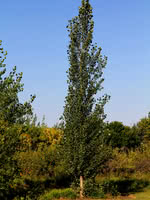Mon-Fri 9am - 5pm Mountain time
Sundancer Poplar vs Black Locust
Populus x ACWS151
Robinia pseudoacacia
The Sundancer Poplar is a fast-growing, columnar hybrid that is resistant to Bronze Leaf Disease. Developed at the Agroforestry Centre in Indian Head, Saskatchewan, this cold hardy tree is well-suited to the Canadian prairies and northern regions.
Adaptable to various soil conditions and drought-tolerant once established, the Sundancer Poplar is an excellent choice for lining properties and roads or creating an attractive hedge.
Black Locust is an attractive tree. Its distinctive leaves are made of about a dozen bright green leaflets. It also notable for its fragrant white flowers, which smell of citrus.
Black Locust can grow in many situations, but prefers dry areas with lots of sun. It is robust and is an excellent choice for establishing shade in dry, open areas.
Important note: Much of the Black Locust is toxic to humans and livestock, including seeds, bark, and leaves.

